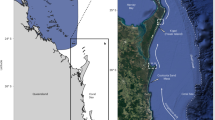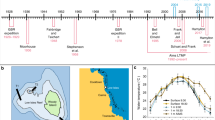Abstract
IN a letter on “Dana's Proof of Darwin's Theory of Coral Reefs”, published in NATURE for April 3, Mr. Cyril Crossland points out that “land valleys which extend beneath the sea are not always proof of subsidence. Such valleys, like coral reefs, may owe their existence to different factors in different tases”. He adds that certain harbours on the east coast of Africa “are the high parts of submarine fault valleys”, which, although they simulate embayments produced by the general depression and partial submergence of a dissected coastal region, really result from the local depression of fault blocks, and hence cannot be taken as evidence that any coral reefs which may occur near them have been built up during a period of submergence.
This is a preview of subscription content, access via your institution
Access options
Subscribe to this journal
Receive 51 print issues and online access
$199.00 per year
only $3.90 per issue
Buy this article
- Purchase on Springer Link
- Instant access to full article PDF
Prices may be subject to local taxes which are calculated during checkout
Similar content being viewed by others
Author information
Authors and Affiliations
Rights and permissions
About this article
Cite this article
DAVIS, W. Submerged Valleys and Barrier Reefs. Nature 91, 423–424 (1913). https://doi.org/10.1038/091423b0
Issue Date:
DOI: https://doi.org/10.1038/091423b0
Comments
By submitting a comment you agree to abide by our Terms and Community Guidelines. If you find something abusive or that does not comply with our terms or guidelines please flag it as inappropriate.



